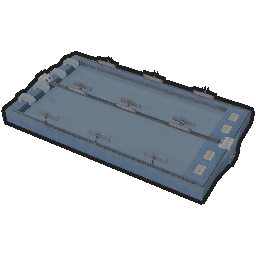Difference between revisions of "Evaporation Pond (Heated)"
Thadius856 (talk | contribs) m (→�: implement {{infoicon}}) |
Thadius856 (talk | contribs) m (→�: implement {{infoicon}}) |
||
| Line 15: | Line 15: | ||
| Variants = [[Evaporation Pond]] | | Variants = [[Evaporation Pond]] | ||
}} | }} | ||
The '''Evaporation Pond (Heated)''' is one of only two machines which can produce {{infoicon|Salt}}, a critical ingredient in {{infoicon|Glass Mix}} and a requirement to manufacture {{infoicon|Glass}}. The other is the [[Evaporation Pond]] variant carries a 60% lower | The '''Evaporation Pond (Heated)''' is one of only two machines which can produce {{infoicon|Salt}}, a critical ingredient in {{infoicon|Glass Mix}} and a requirement to manufacture {{infoicon|Glass}}. The other is the [[Evaporation Pond]] variant carries a 60% lower {{infoicon|Worker|ui-yes}}, 33% lower [[Maintenance]], and no {{infoicon|Electricity}} cost, but also has a 75% lower throughput. | ||
Salt can be created using either {{infoicon|Seawater}} from a [[Seawater Pump]] or from the {{infoicon|Brine}} byproduct of a [[Thermal Desalinator]]. Due to the greatly elevated | Salt can be created using either {{infoicon|Seawater}} from a [[Seawater Pump]] or from the {{infoicon|Brine}} byproduct of a [[Thermal Desalinator]]. Due to the greatly elevated {{infoicon|Electricity}} requirements of Thermal Desalinators, production of Salt from Brine should generally only be considered if cases where there is already a supply of Brine which would otherwise be dumped back into the ocean, a significant source of excess non-polluting Electricity exists, or there are significant space constraints. | ||
==Recipes== | ==Recipes== | ||
Revision as of 06:19, 22 January 2022
| Construction | |
| Workers | |
| Electricity | |
| Maintenance | |
| Footprint | 15x9 |
| Required Research | Salt Production |
| Designation | Water Extraction & Processing |
| Variants | Evaporation Pond |
The Evaporation Pond (Heated) is one of only two machines which can produce Salt, a critical ingredient in Glass Mix and a requirement to manufacture Glass. The other is the Evaporation Pond variant carries a 60% lower Worker, 33% lower Maintenance, and no Electricity cost, but also has a 75% lower throughput.
Salt can be created using either Seawater from a Seawater Pump or from the Brine byproduct of a Thermal Desalinator. Due to the greatly elevated Electricity requirements of Thermal Desalinators, production of Salt from Brine should generally only be considered if cases where there is already a supply of Brine which would otherwise be dumped back into the ocean, a significant source of excess non-polluting Electricity exists, or there are significant space constraints.
